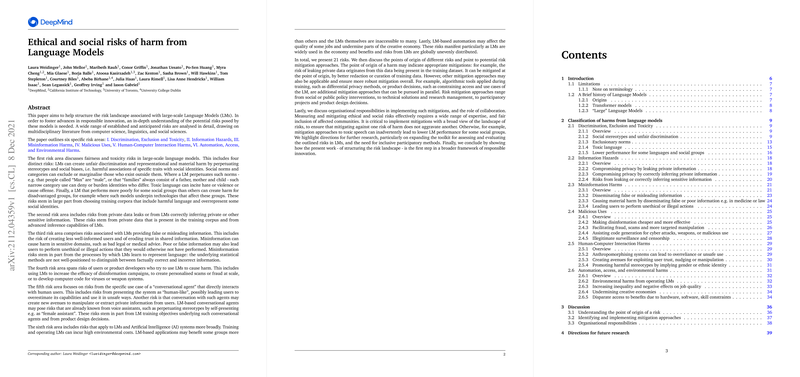Ethical and Social Risks of Harm from LLMs
The paper "Ethical and social risks of harm from LLMs" provides an extensive taxonomy of the potential risks associated with the development and use of large-scale LLMs (LMs). The paper analyses risks from a multidisciplinary perspective, drawing on insights from computer science, linguistics, and social sciences to help structure the risk landscape and foster responsible innovation in this area. The discussed risks are organized into six broad categories: Discrimination, Exclusion and Toxicity; Information Hazards; Misinformation Harms; Malicious Uses; Human-Computer Interaction Harms; and Automation, Access, and Environmental Harms.
Discrimination, Exclusion and Toxicity
This category covers risks stemming from the biases present in the training corpora of LMs. It identifies four significant areas: social stereotypes and unfair discrimination, exclusionary norms, toxic language, and lower performance for marginalized social groups. The risk factors mainly arise from the underrepresentation and biased depiction of minority groups in the training data, perpetuating existing inequalities. For instance, these models may reflect and amplify harmful stereotypes, such as associating certain attributes with specific social identities.
Key challenges include the need for better documentation of biases in training datasets and more inclusive data curation methods. Another notable issue is that even within a single language, variations in dialect, slang, and sociolect can lead to differential performance, disadvantaging particular social groups.
Information Hazards
Information hazards describe risks associated with LMs potentially leaking or inferring sensitive or private information. This includes three main types: leaking private information directly from training data, inferring private information through advanced algorithms, and revealing sensitive information that can cause harm. These risks highlight the need for robust privacy-preserving techniques such as differential privacy during model training and more stringent data curation processes.
Misinformation Harms
LMs are prone to generating false or misleading information, mainly because the statistical methods underlying them are not designed to distinguish between factual and incorrect information. The potential harms are wide-ranging and include providing erroneous legal or medical advice and eroding trust in shared information. This section underscores the limitations of current LMs in reliably providing true information and suggests that even scaling up model size will not fully solve these issues. The paper calls for more stringent benchmarks to assess the factual accuracy of LMs, especially in high-stakes domains.
Malicious Uses
This section explores how LMs can potentially be weaponized to cause harm intentionally. This includes reducing the cost and increasing the efficacy of disinformation campaigns, perpetrating fraud and scams, generating malicious code, and enhancing surveillance and censorship capabilities. The risks from malicious uses of LMs are contingent on the accessibility and utilization of these models by bad actors.
Human-Computer Interaction Harms
Risks in this category arise from the interaction between humans and conversational agents (CAs) based on LMs. Key concerns include the anthropomorphizing of LMs, which could lead users to overestimate their capabilities, and the potential for these models to exploit user trust, manipulating users or extracting private information. Another risk involves the reinforcement of harmful stereotypes, for instance, by designing assistant tools that default to female characteristics, thereby perpetuating gender biases.
Automation, Access, and Environmental Harms
The final category examines broader societal harms, such as the environmental costs associated with training and operating LMs, and the potential for these models to exacerbate existing inequalities. This includes negative impacts on job quality and employment, especially in industries prone to automation. The paper suggests that the computational cost and environmental impact of running these models need to be addressed, possibly through efficiency gains and responsible deployment practices.
Implications and Future Research
The paper's extensive taxonomy of risks provides a roadmap for identifying and mitigating these hazards. It stresses the necessity of interdisciplinary collaboration and inclusive dialogue among stakeholders, including affected communities. Future research directions include expanding the toolkit for risk assessment, developing more inclusive datasets, and setting normative performance thresholds for LMs.
Importantly, this paper serves as a foundational step in the field's broader effort to ensure that advances in LM technology are accompanied by responsible innovation. While the focus is on identifying risks, the ultimate goal is to create frameworks and tools that can guide the development of LMs in ways that maximize benefits while minimizing harms.
In conclusion, while the potential of large-scale LLMs is significant, this paper highlights the crucial need for comprehensive risk assessment and targeted mitigations to address both current and anticipated ethical and social challenges. The collaborative effort emphasized throughout the paper is essential for achieving responsible innovation in this rapidly evolving field.
